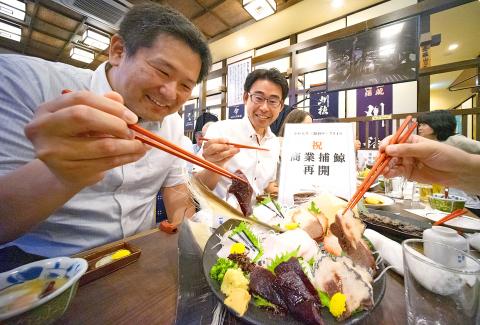“Two sashimis, three steaks,” cries the waitress at one of Tokyo’s most famous whale restaurants during a frantic lunchtime service, where Japan’s resumption of commercial whaling has cooked up new hope.
Mitsuo Tani has spent 46 of his 64 years preparing and cooking whale meat and hosts a mixed clientele at his restaurant: salarymen in white shirts gulping down a quick lunch before heading back to the office, single women, retired couples.
Whale steak is the most popular dish at US$9 — a thin rectangular piece of meat with as much rice, miso soup, vegetables and iced tea as the customer can eat. Also flying out of the kitchen is whale sashimi — raw slices of whale flesh, skin or liver.

Photo: EPA-EFE
Japan’s resumption of commercial whaling has prompted fury from other countries and campaigners, with activists saying that one of the three species targeted is threatened with extinction and sub-populations of the other two are depleted.
But veteran whale chef Tani is keen to promote the health benefits of whale meat.
“It is five times lower in calories than beef, 10 times lower in cholesterol, two times less fat than chicken. It’s packed with iron. But abroad, people do not know this,” he said.
Not all would agree with Tani’s health-based sales pitch, however. In 2015, when the Environmental Investigation Agency tested the mercury levels of whale meat sold in Japan, they found it riddled with the substance.
Whipping up a “whale roast beef” at the pass, Tani explained that he had to move from the northern city of Sendai after the 2011 tsunami and the price of whale meat soared amid a significant drop in supply.
In Tokyo, he has never had any problem procuring meat. While Japan was still part of the International Whaling Commission (IWC), the whales caught in Antarctic waters for “research” purposes still ended up as sashimi and steak on plates around the country.
Ironically, with Japan leaving the IWC and resuming commercial whaling off its own coast, the quantity of meat may decline.
Japan set an annual quota of more than 600 whales while in the IWC.
The cap now stands at 227 until the end of the year — 52 minke, 150 Bryde’s and 25 sei whales.
It is not the only country carrying out hunts, with Norway and Iceland conducting them in recent years and indigenous people from Alaska to Greenland allowed exemptions to the moratorium.
Hitting back at those who fear the resumption of commercial whaling further endangers whales, Japanese authorities say the quotas have been set carefully “to keep the whale population at a sustainable level.”
“I’m scared that the quantity of whale meat will go down,” admitted Tani.
‘WELL COOKED’
Another whale restaurant boss, Sumiko Koizumi, hailed the resumption of whaling as “an excellent thing” and said it was down to chefs to promote the meat and dream up new recipes.
Removing the stigma around whale meat will make it easier for consumers, she said, “first because supermarkets will be more inclined to offer it and wholesalers will listen more to our needs and be in a position to meet them.”
Kenta Yodono, sales manager at the Kyodo whaling firm that operates Japan’s flagship whaling boat, said the commercial hunts would catch different species of whales, which would taste slightly different.
“The commercial species will be different and certain people might be concerned that they will not have the same taste. But in general, I think the quality will improve and we can respond to restaurants’ needs,” Yodono said.
He acknowledged activists’ concerns over the cruelty of the whale hunt and said “the fishermen are conscious of the fact that the time the animal suffers should be reduced.”
However, Tani does have some fears over the immediate future of his industry, with few chefs training to acquire the specialized cooking skills required.
“With commercial whaling halted for more than 30 years, no one has got into the business and that will not happen overnight,” he said.
“Even if some people get into it now, it will take 30 years. And if they find the work too hard, they will stop. Whale needs to be well-cooked otherwise no one will start to eat it again,” added Tani.
Japan has defended the controversial whale hunt as a key part of its tradition and rich culinary heritage. And Tani agreed.
“A country that does not preserve its food culture has no future.”

On Jan. 17, Beijing announced that it would allow residents of Shanghai and Fujian Province to visit Taiwan. The two sides are still working out the details. President William Lai (賴清德) has been promoting cross-strait tourism, perhaps to soften the People’s Republic of China’s (PRC) attitudes, perhaps as a sop to international and local opinion leaders. Likely the latter, since many observers understand that the twin drivers of cross-strait tourism — the belief that Chinese tourists will bring money into Taiwan, and the belief that tourism will create better relations — are both false. CHINESE TOURISM PIPE DREAM Back in July

Could Taiwan’s democracy be at risk? There is a lot of apocalyptic commentary right now suggesting that this is the case, but it is always a conspiracy by the other guys — our side is firmly on the side of protecting democracy and always has been, unlike them! The situation is nowhere near that bleak — yet. The concern is that the power struggle between the opposition Chinese Nationalist Party (KMT) and their now effectively pan-blue allies the Taiwan People’s Party (TPP) and the ruling Democratic Progressive Party (DPP) intensifies to the point where democratic functions start to break down. Both

This was not supposed to be an election year. The local media is billing it as the “2025 great recall era” (2025大罷免時代) or the “2025 great recall wave” (2025大罷免潮), with many now just shortening it to “great recall.” As of this writing the number of campaigns that have submitted the requisite one percent of eligible voters signatures in legislative districts is 51 — 35 targeting Chinese Nationalist Party (KMT) caucus lawmakers and 16 targeting Democratic Progressive Party (DPP) lawmakers. The pan-green side has more as they started earlier. Many recall campaigns are billing themselves as “Winter Bluebirds” after the “Bluebird Action”

Taiwan doesn’t have a lot of railways, but its network has plenty of history. The government-owned entity that last year became the Taiwan Railway Corp (TRC) has been operating trains since 1891. During the 1895-1945 period of Japanese rule, the colonial government made huge investments in rail infrastructure. The northern port city of Keelung was connected to Kaohsiung in the south. New lines appeared in Pingtung, Yilan and the Hualien-Taitung region. Railway enthusiasts exploring Taiwan will find plenty to amuse themselves. Taipei will soon gain its second rail-themed museum. Elsewhere there’s a number of endearing branch lines and rolling-stock collections, some